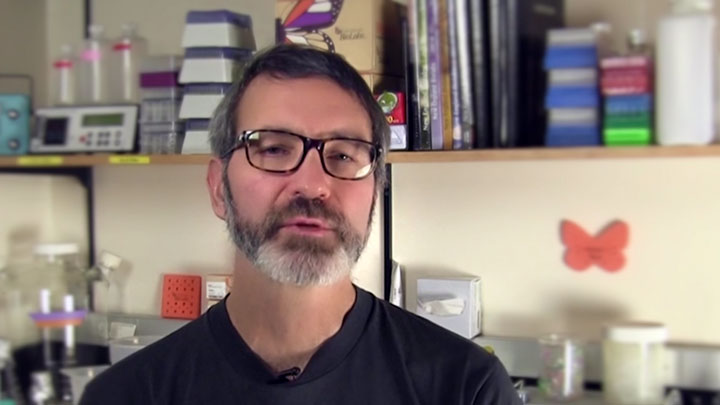NEB® TV Ep. 23 – Colorimetric LAMP in point-of-care diagnostics
Script
NEB TV what's trending in science.
Deana Martin:
Welcome to NEB TV. Today, I am joined by Nathan Tanner, who is a staff scientist here at NEB. Hi, Nathan.
Nathan Tanner:
Hi, Deana.
Deana Martin:
And we're talking about Colorimetric LAMP and its applications in human health. Nathan, we talked about Colorimetric LAMP a few years ago, what has changed since then?
Nathan Tanner:
So, at that time it was a new technology we were excited about, but since then we have released a formulation as a product, people can buy it and it's gotten out to the field for a lot of people to try it in new and exciting ways.
Deana Martin:
In our Science in 60, Nathan will give us an overview of how Colorimetric LAMP works. Then we will hear from Scott O'Neill who is the director of the World Mosquito Program, as well as one of our previous Passion in Science winners, and he will tell us how they are using Colorimetric LAMP to screen for mosquito's in order to prevent mosquito born illnesses.
Then we'll hear from Nathan, as well as other scientists here at NEB about some publications that use LAMP in interesting applications.
Deana Martin:
Are you ready?
Nathan Tanner:
Let's do it.
Deana Martin:
Alright, let's get started.
Science in 60
Nathan Tanner:
So, we work on a lot of DNA polymerases and amplification methods here at NEB and in particular interest are isothermal amplification methods, where you look for a DNA or RNA target of interest at a single temperature and this lets you get away with not heating and cooling the sample like you have to do for PCR, so you can use a very simple instrument or even a cup of hot water.
So in looking at these methods you still need to know if the amplification happens. We took advantage of a natural feature of a DNA polymerase and for every dNTP that's incorporated in the DNA strand you produce a proton.
In a reaction like LAMP, which is done at a single temperature, you make a lot of DNA and accordingly, this is a lot of protons and it can actually change the pH of the reaction. We took our robust LAMP amplification method and added in a visual pH indicator, which lets you see if the reaction occurs through a color change. This lets us take a nice molecular tool from the lab out to the field, where you can detect a few copies of a target in just a few minutes without any need for a detector or instrument of any kind.
This creates a really robust and sensitive field based amplification platform.
Applications of LAMP in the Field: A Conversation with Scott O'Neill, Ph.D. Director, World Mosquito Programs & 2016 NEB Passion in Science Awardee
How is the World Mosquito Program using mosquitoes to eliminate the harmful diseases that they spread?
Scott O'Neill:
The World Mosquito Program is releasing mosquitoes that contain Wolbachia. Wolbachia is a naturally occurring bacteria and what it does is stops the ability of the mosquito to transmit various viruses to people, viruses like Dengue, Chikungunya, and Zika that cause devastating diseases around the world.
Why is it helpful to screen mosquitoes in the field where you're releasing them as opposed to taking them back to analyze?
We need to know where the mosquitoes contain Wolbachia or not to know whether it's successful in our program and to get the most effective and timely information, we would like to do that screening simply and quickly in the field. To do that we need a simple assay that is appropriate for the field and we find that the LAMP Colorimetric assay is very good for that.
What makes LAMP an attractive amplification method for WMP?
LAMP's attractive for us because it's very simple to do. It doesn't require any upfront capital expenditure or expensive equipment and can be done at high throughput in the field.
How does Colorimetric LAMP help enable your release programs?
What I particularly like about the Colorimetric LAMP reagent set is that the assay is very easy to look at with the eye and make a determination quickly if the mosquito is infected with Wolbachia or not.
Where do you plan to use Colorimetric LAMP in your trials?
We currently using Colorimetric LAMP in a number of our field sites in various countries around the world. Our program is really focused at the moment into Central and South America and into Asia in the Pacific region. We have a number of countries across those regions that are currently using this diagnostic and based on the results we're getting we hope to expand it to a number of additional countries.
Learn more about Scott's work at:
www.Worldmosquitoprogram.org
Diverse Applications of Colorimetric LAMP:
Nathan Tanner:
The LAMP is a popular and widely used isothermal amplification method and scores of publication have come out using it to test for all kinds of targets, from a wide range of samples, from pets and animals, to agricultural, to human health.
We think that the Colorimetric LAMP mix will enable a new kind of simple visual field based, or a point of care test. A few good examples of this, we've seen, one we did with CDC in Fort Collins Colorado, they were testing Zika from urine samples of pregnant women, the idea being to be a quick test done in the clinic, so right there with the patient at the point of care.
Another good example for human health was from the University of Pennsylvania where they built a simple microfluidic device to test for Malaria and Meningitis, directly from cerebral spinal fluid, so being able to directly look at the reaction in the chip was valuable for that method.
Then another interesting example came from Germany, where a group was testing wine grapes for the presence of a fungus that can be a problem for the vineyards. So the thought there would be to test in the field with grapes outside ... An interesting approach but things like that we think are a good use of Colorimetric LAMP.
Catherine Poole:
So, NEB has been working on filarial parasites for a long time and one of our main focuses of research is to develop diagnostic techniques that are field deploy-able all the way around the globe.
Filarial parasites are nematode parasite that infect people in the tropics. They cause diseases known as lymphatic filariasis commonly known as Elephantiasis and African River Blindness. So, while filarial infections are not fatal, they are extremely debilitating and whole communities can suffer.
LAMP is a really good way of detecting filarial parasites, because you can design very sensitive and very species-specific assays. Reactions are very simple to set up. It simply requires a set of primers, a polymerase and your target DNA. They are very rapid. They can be completed in 30-60 minutes and there are a variety of different read outs.
NEB has developed Colorimetric master mix that's very simple to use, where reactions turn from a negative color of pink into a very vivid yellow.
So, because LAMP has proven to be a great method for diagnosing filarial infections as well as a variety of other tropical diseases, NEB is working to expand it's usefulness by developing multiplex LAMP so that we might be able to detect multiple parasites in a single reaction simultaneously.
Deana Martin:
Nathan, thanks so much for joining me today.
Nathan Tanner:
Oh, no problem, thanks for having me.
Deana Martin:
And as always if you have any suggestions for future episodes, please let us know.
Related Videos
-

NEB® TV Ep. 3 – DNA Amplification -

Restriction Enzymes in Isothermal Amplification -

Loop Mediated Isothermal Amplification (LAMP) Tutorial

